Abstract
1. The human abductor pollicis brevis (APB) and first dorsal interosseus (FDI) were fatigued by sustained maximal voluntary contractions and, in the case of the APB also by electrically induced (30 Hz) contractions, until the loss of force reached 50% of control. The short latency or Hoffmann reflex (H reflex) and the long latency reflex (LLR) were evoked during weak voluntary contractions by the electrical stimulation of the median nerve at the wrist in control, during and after the fatigue experiments. 2. As compared to control, the normalized H reflex amplitude in the two fatigue modalities was found to have decreased by 30% without any significant change in the LLR. This finding and the observation that the LLR was enhanced by 46% in simultaneous recordings, in which the APB remained at rest during FDI fatigue, could be explained by a stronger descending fatigue-induced central drive which spreads to neighbouring non-fatigued muscles. 3. A comparison of the H reflex and the LLR behaviour during fatigue indicates that motoneurone activation threshold is not affected but that changes in peripheral drive are present, which possibly induce presynaptic inhibition of Ia afferents and/or inhibition of interneurones in the oligosynaptic pathways. Our observation of a rather slow time course for the H reflex decrease during fatigue supports the point of view that these inhibitions are activated by metabolic and/or chemical changes in the fatigued muscle. 4. It is concluded from the results of this study that muscle fatigue induces an enhanced descending supraspinal drive which compensates for a loss of excitation from the peripheral afferents on motoneurones.
Full text
PDF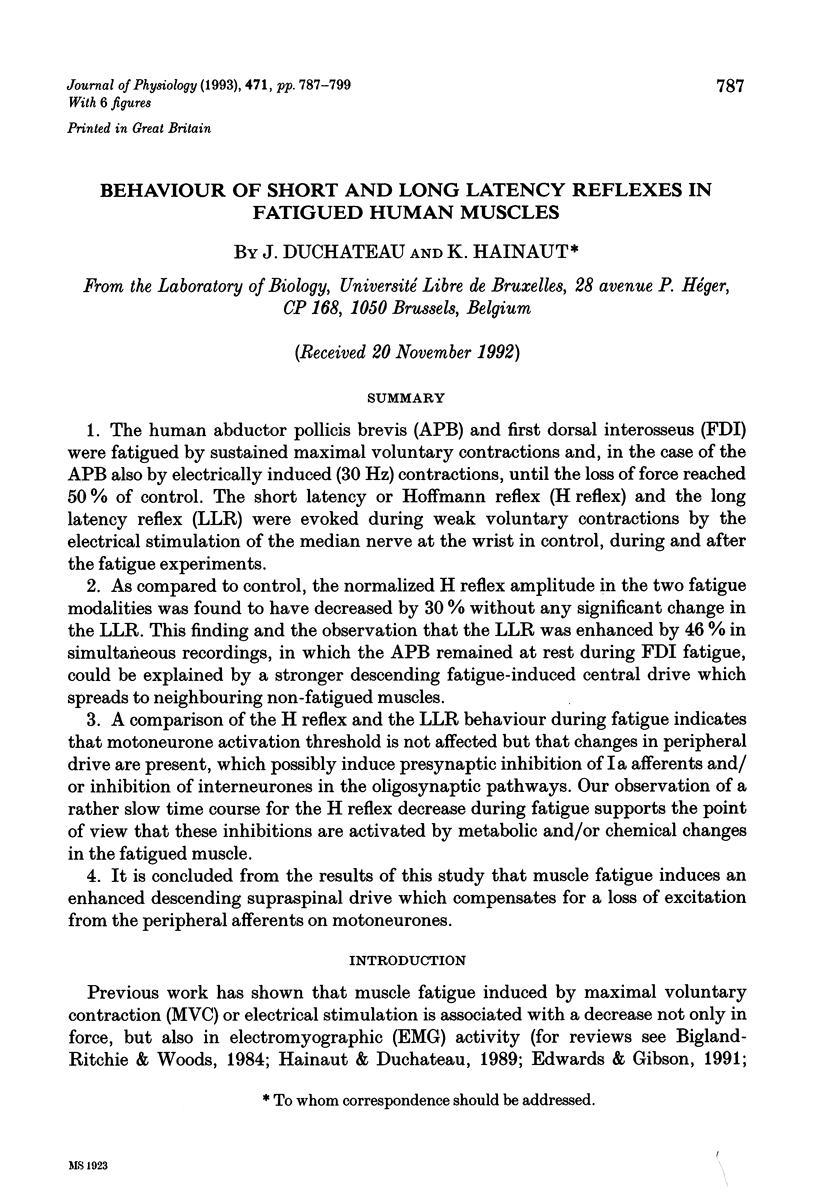
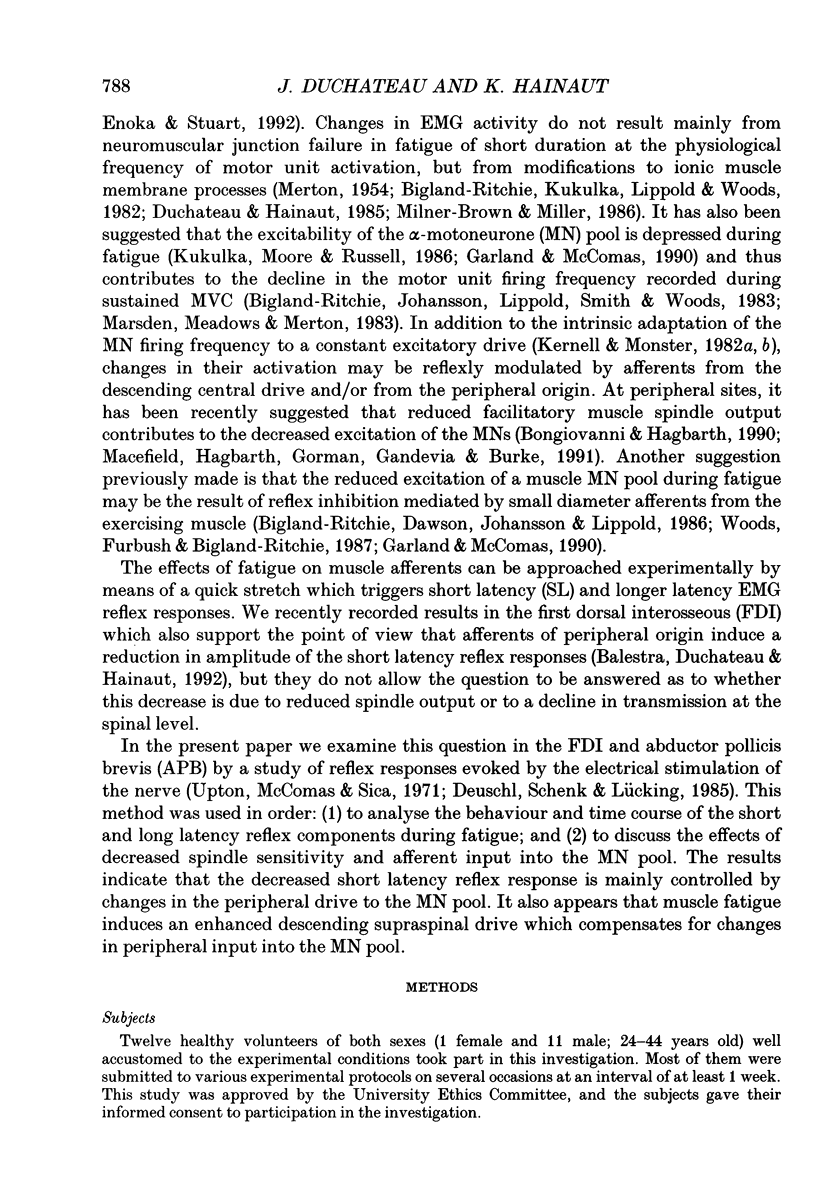
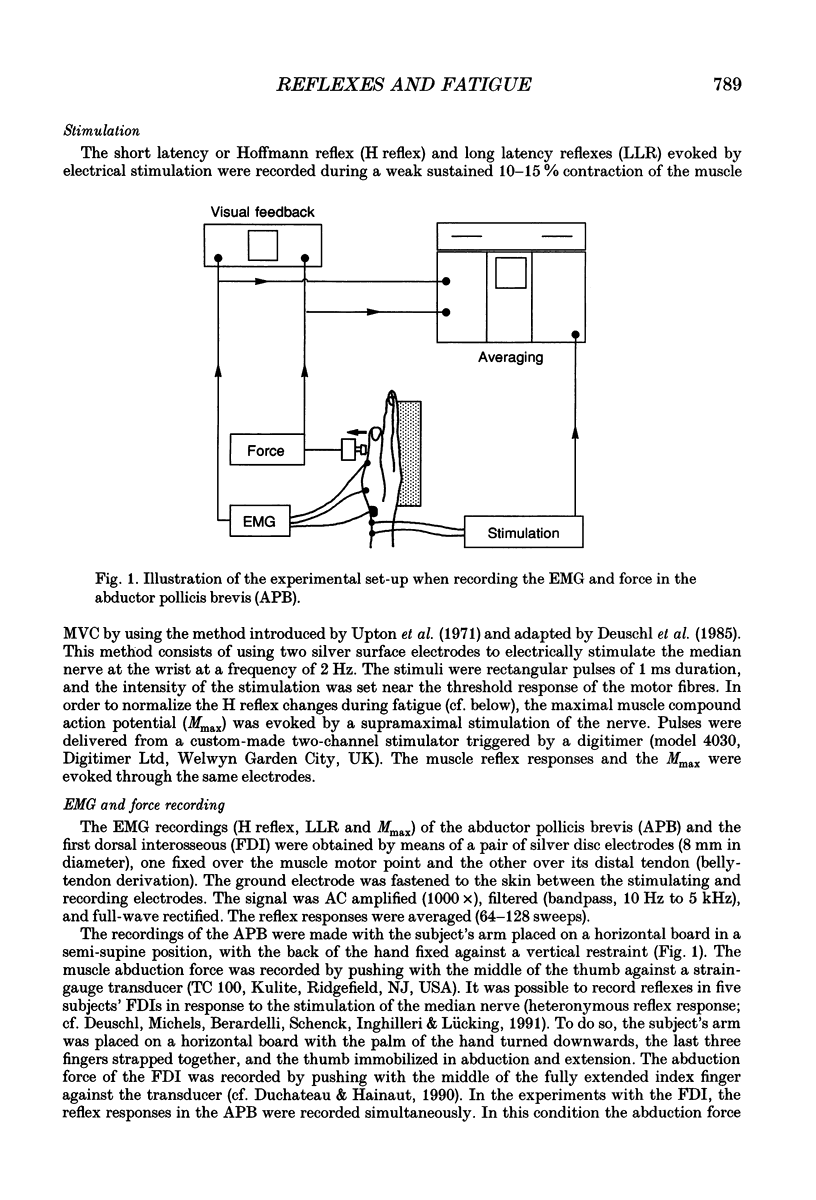
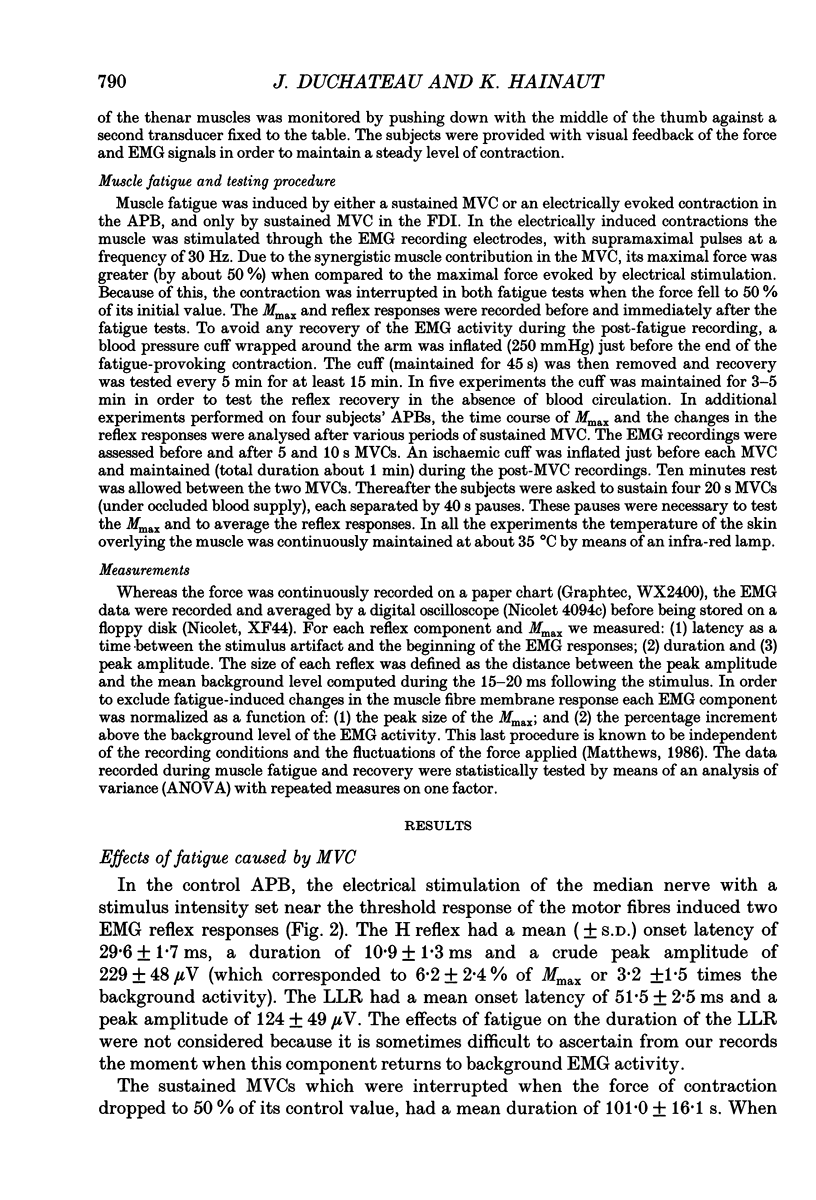
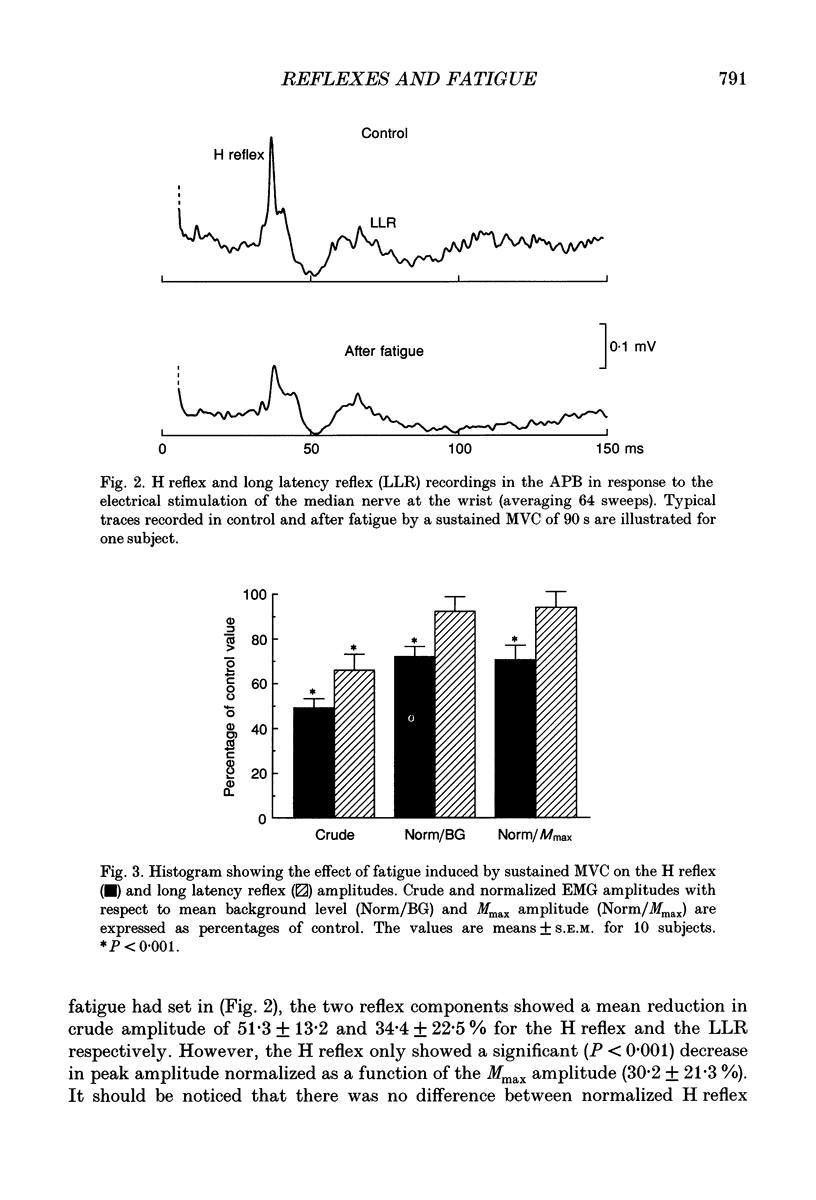
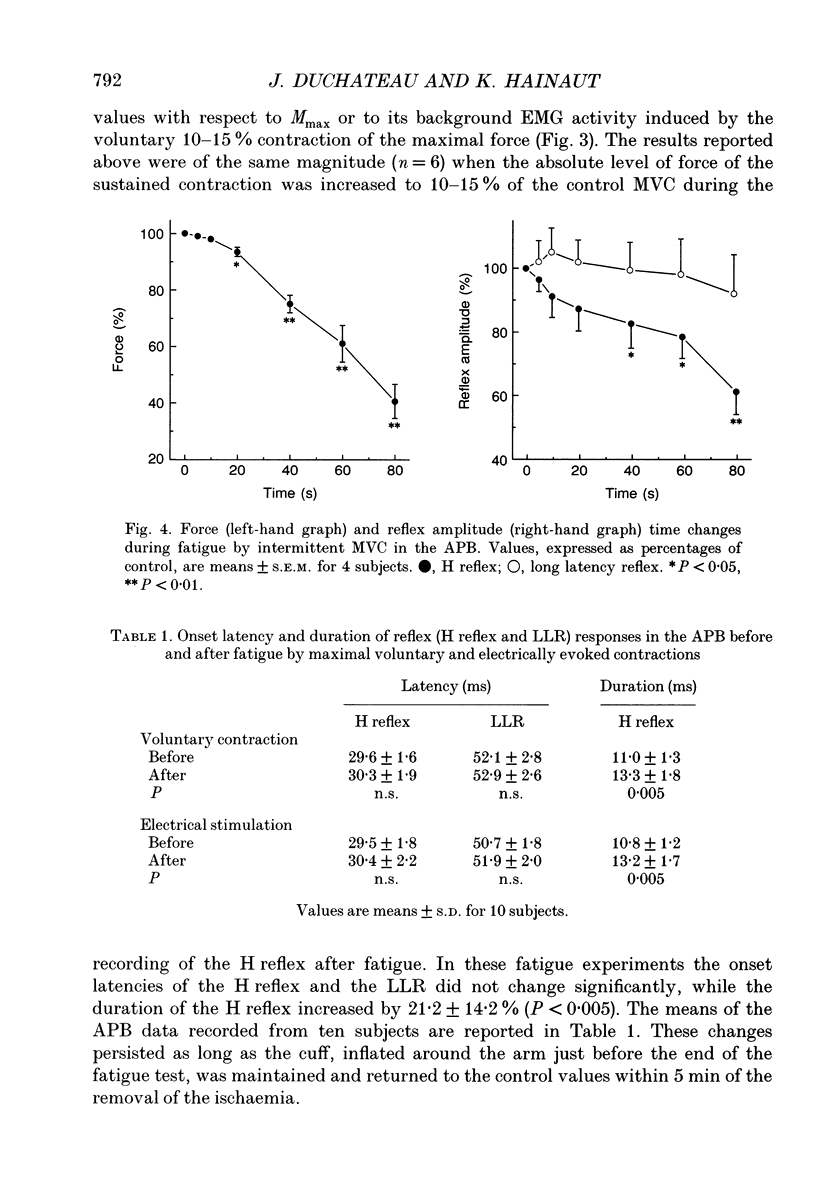
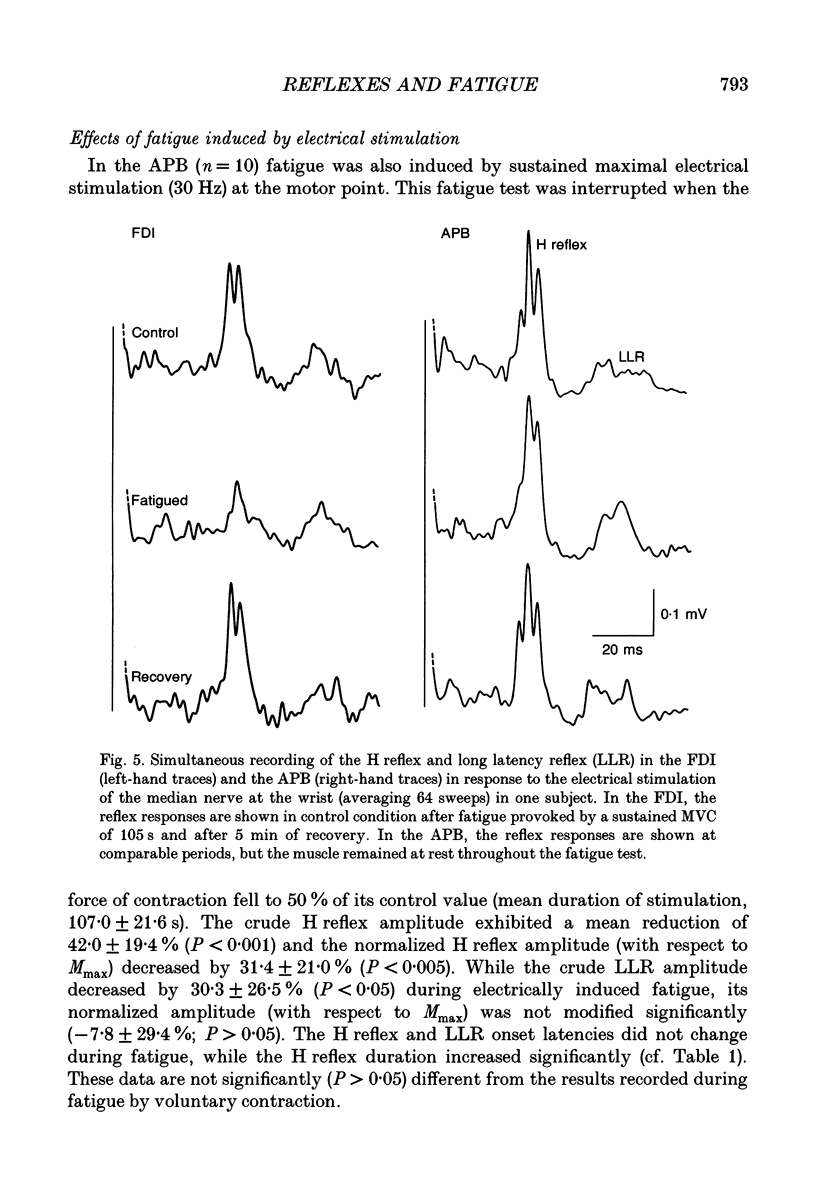
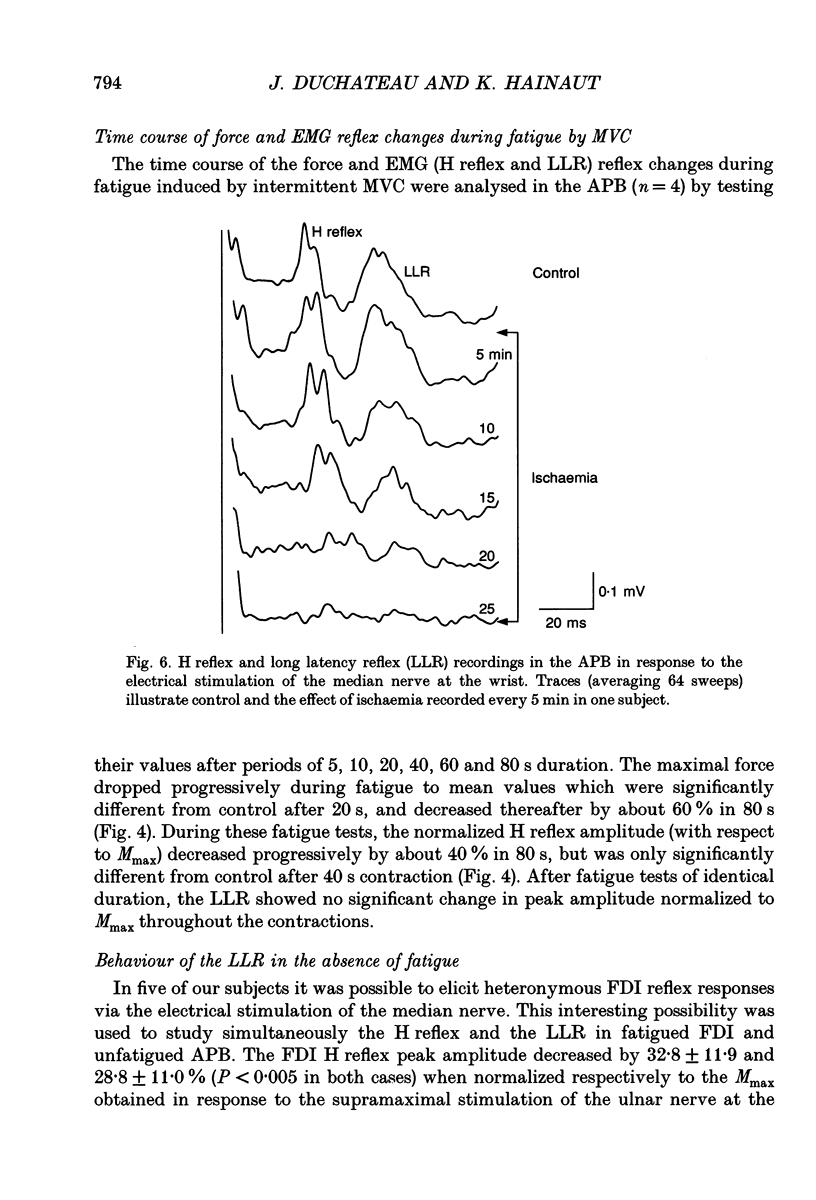
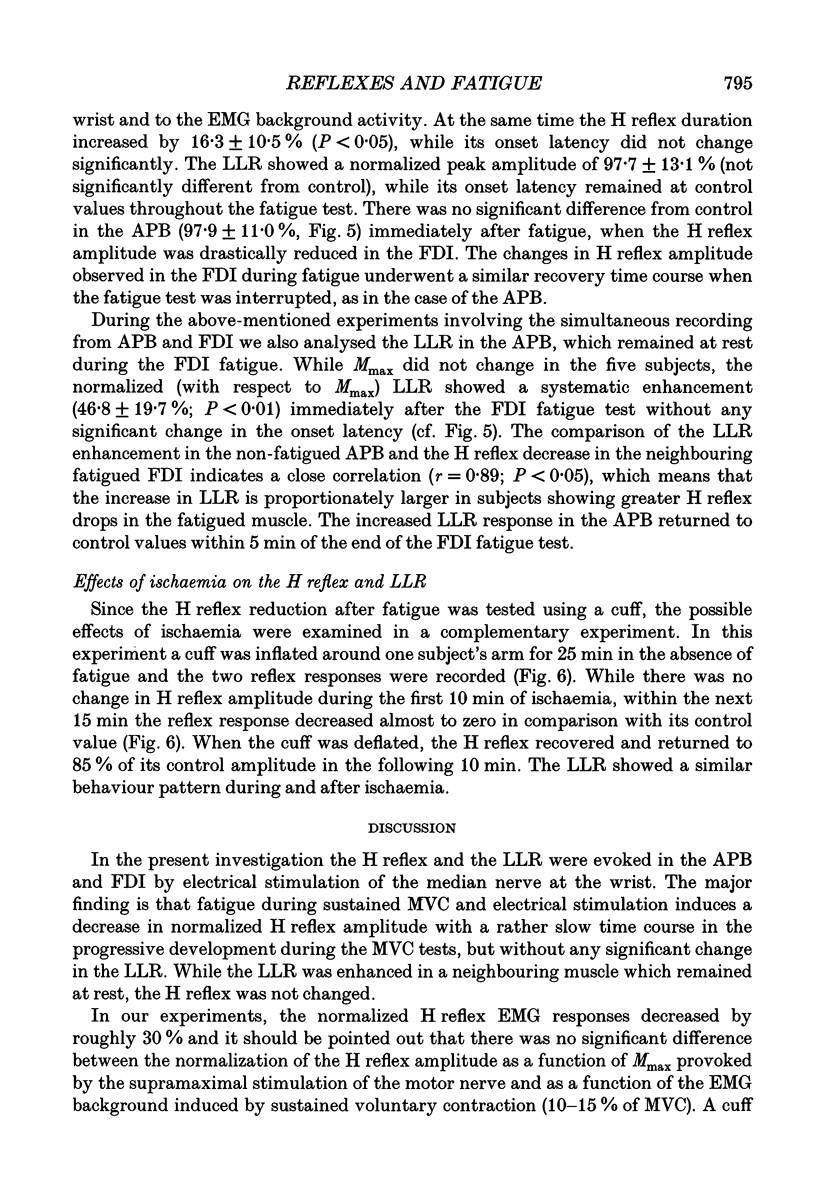
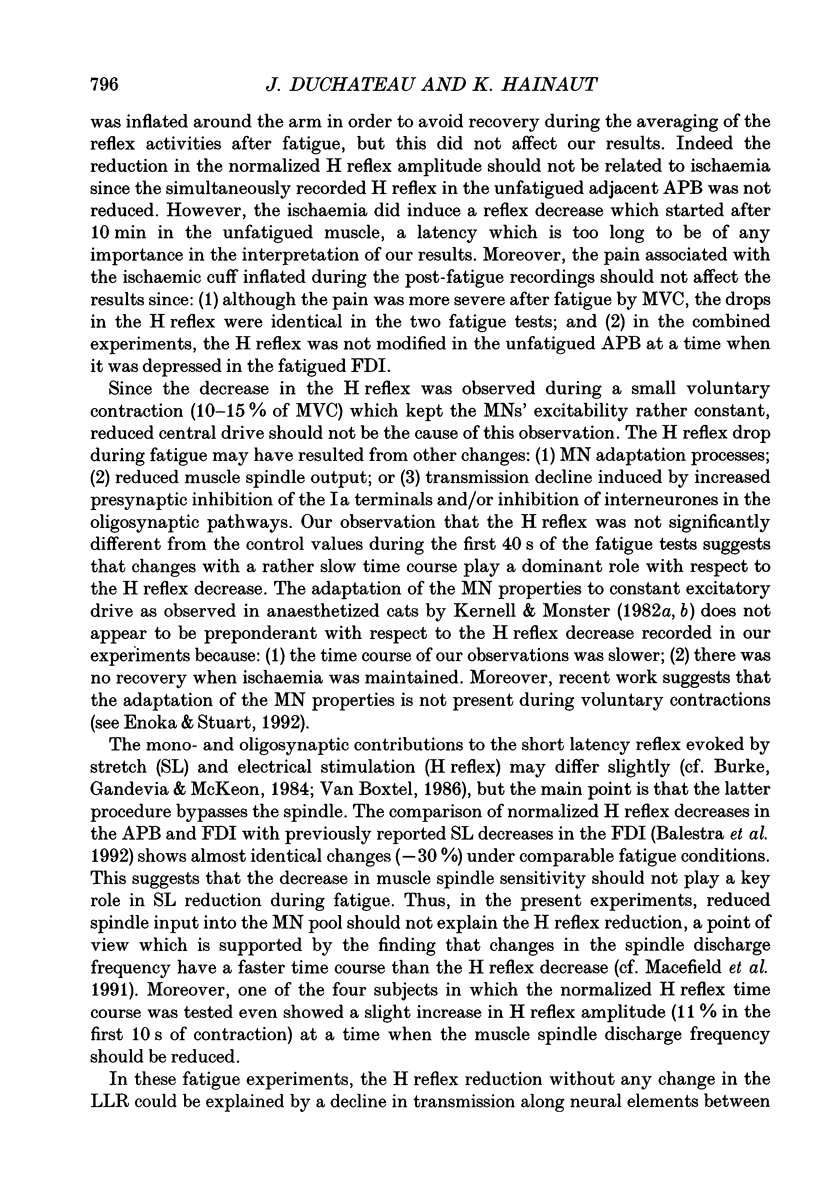
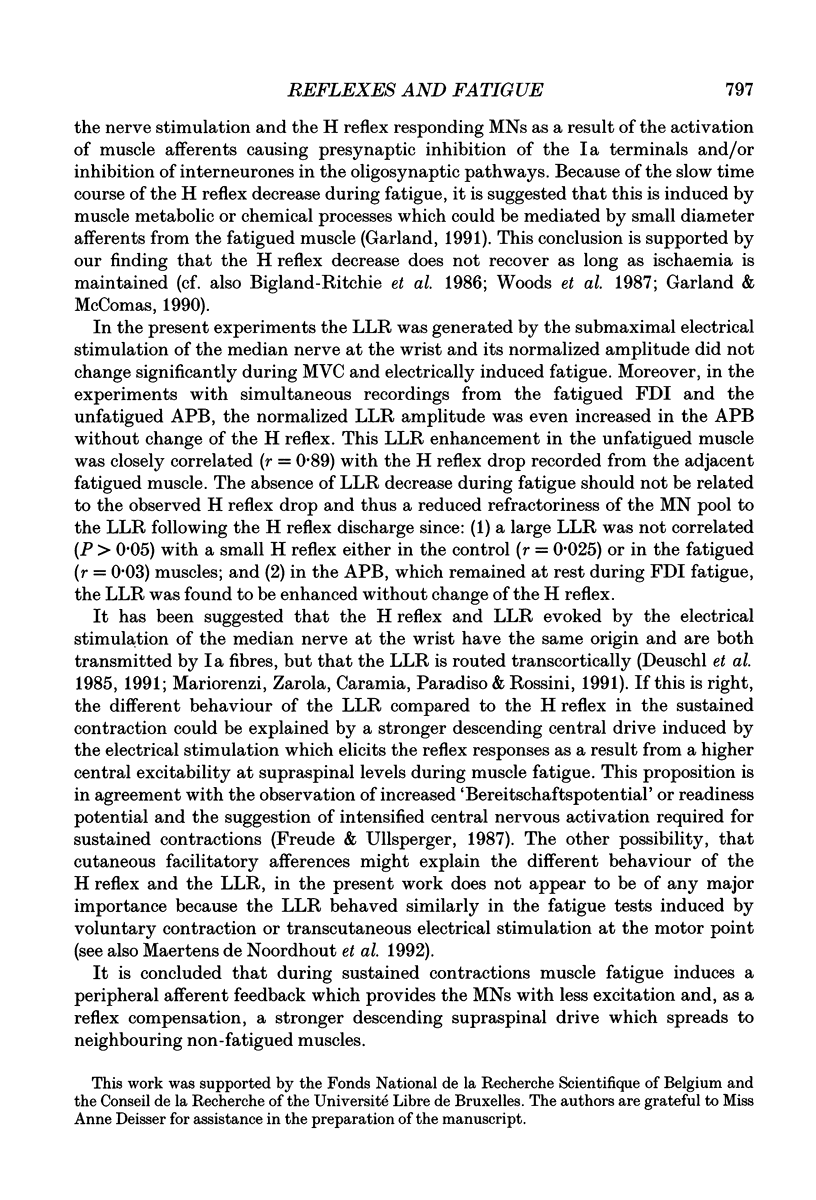
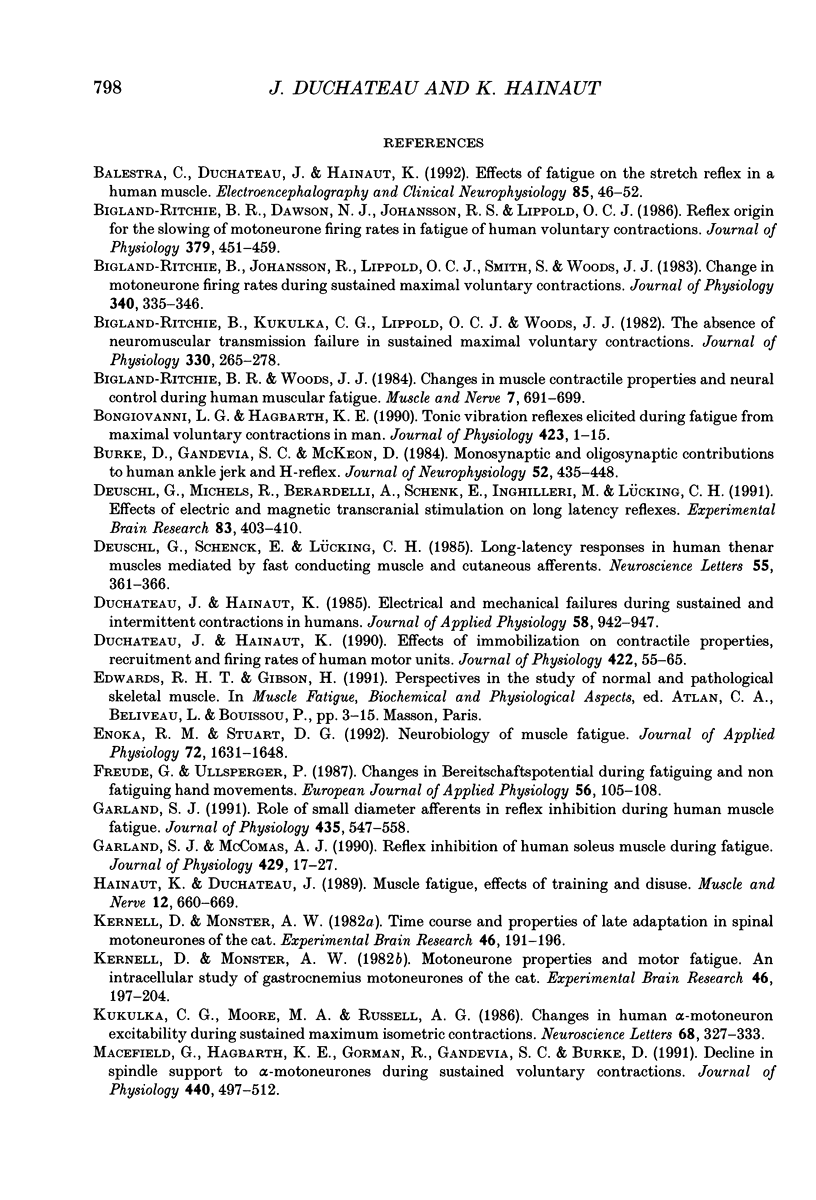
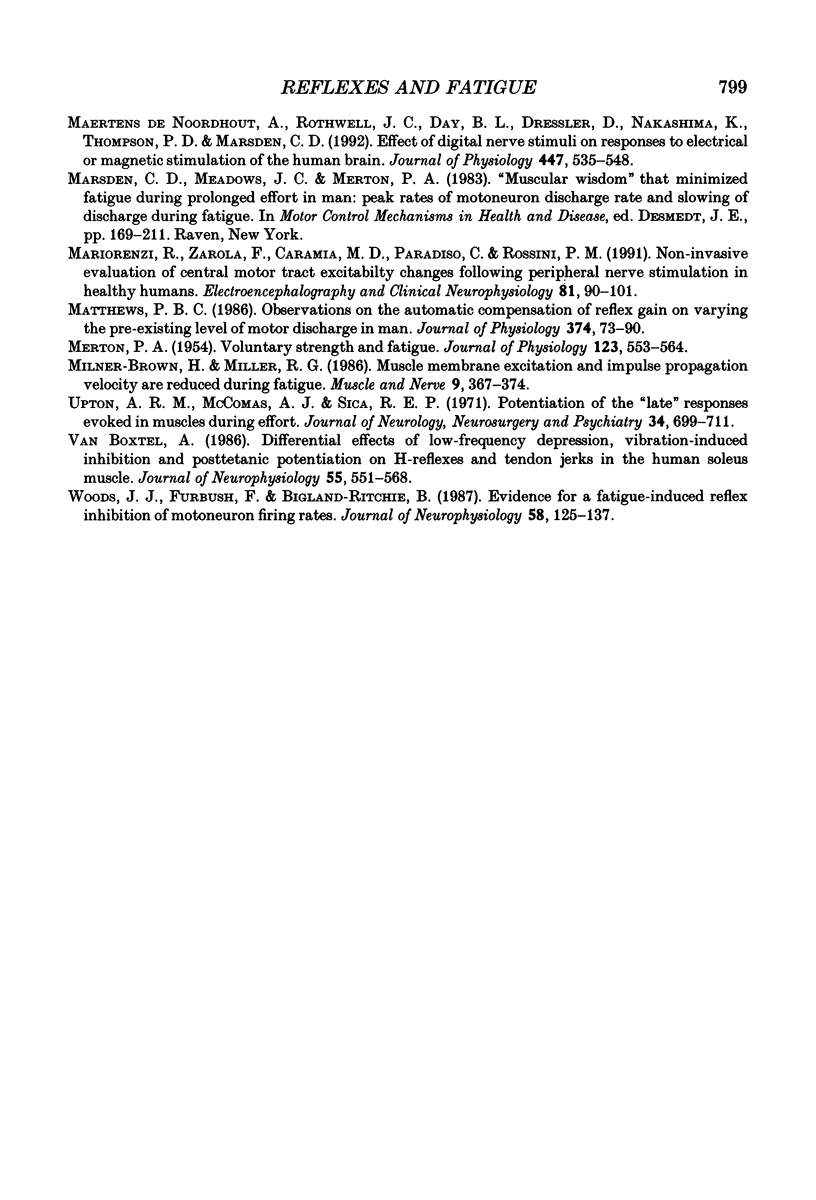
Selected References
These references are in PubMed. This may not be the complete list of references from this article.
- Balestra C., Duchateau J., Hainaut K. Effects of fatigue on the stretch reflex in a human muscle. Electroencephalogr Clin Neurophysiol. 1992 Feb;85(1):46–52. doi: 10.1016/0168-5597(92)90101-g. [DOI] [PubMed] [Google Scholar]
- Bigland-Ritchie B. R., Dawson N. J., Johansson R. S., Lippold O. C. Reflex origin for the slowing of motoneurone firing rates in fatigue of human voluntary contractions. J Physiol. 1986 Oct;379:451–459. doi: 10.1113/jphysiol.1986.sp016263. [DOI] [PMC free article] [PubMed] [Google Scholar]
- Bigland-Ritchie B., Johansson R., Lippold O. C., Smith S., Woods J. J. Changes in motoneurone firing rates during sustained maximal voluntary contractions. J Physiol. 1983 Jul;340:335–346. doi: 10.1113/jphysiol.1983.sp014765. [DOI] [PMC free article] [PubMed] [Google Scholar]
- Bigland-Ritchie B., Kukulka C. G., Lippold O. C., Woods J. J. The absence of neuromuscular transmission failure in sustained maximal voluntary contractions. J Physiol. 1982 Sep;330:265–278. doi: 10.1113/jphysiol.1982.sp014340. [DOI] [PMC free article] [PubMed] [Google Scholar]
- Bigland-Ritchie B., Woods J. J. Changes in muscle contractile properties and neural control during human muscular fatigue. Muscle Nerve. 1984 Nov-Dec;7(9):691–699. doi: 10.1002/mus.880070902. [DOI] [PubMed] [Google Scholar]
- Bongiovanni L. G., Hagbarth K. E. Tonic vibration reflexes elicited during fatigue from maximal voluntary contractions in man. J Physiol. 1990 Apr;423:1–14. doi: 10.1113/jphysiol.1990.sp018007. [DOI] [PMC free article] [PubMed] [Google Scholar]
- Burke D., Gandevia S. C., McKeon B. Monosynaptic and oligosynaptic contributions to human ankle jerk and H-reflex. J Neurophysiol. 1984 Sep;52(3):435–448. doi: 10.1152/jn.1984.52.3.435. [DOI] [PubMed] [Google Scholar]
- Deuschl G., Michels R., Berardelli A., Schenck E., Inghilleri M., Lücking C. H. Effects of electric and magnetic transcranial stimulation on long latency reflexes. Exp Brain Res. 1991;83(2):403–410. doi: 10.1007/BF00231165. [DOI] [PubMed] [Google Scholar]
- Deuschl G., Schenck E., Lücking C. H. Long-latency responses in human thenar muscles mediated by fast conducting muscle and cutaneous afferents. Neurosci Lett. 1985 Apr 19;55(3):361–366. doi: 10.1016/0304-3940(85)90462-8. [DOI] [PubMed] [Google Scholar]
- Duchateau J., Hainaut K. Effects of immobilization on contractile properties, recruitment and firing rates of human motor units. J Physiol. 1990 Mar;422:55–65. doi: 10.1113/jphysiol.1990.sp017972. [DOI] [PMC free article] [PubMed] [Google Scholar]
- Duchateau J., Hainaut K. Electrical and mechanical failures during sustained and intermittent contractions in humans. J Appl Physiol (1985) 1985 Mar;58(3):942–947. doi: 10.1152/jappl.1985.58.3.942. [DOI] [PubMed] [Google Scholar]
- Enoka R. M., Stuart D. G. Neurobiology of muscle fatigue. J Appl Physiol (1985) 1992 May;72(5):1631–1648. doi: 10.1152/jappl.1992.72.5.1631. [DOI] [PubMed] [Google Scholar]
- Freude G., Ullsperger P. Changes in Bereitschaftspotential during fatiguing and non-fatiguing hand movements. Eur J Appl Physiol Occup Physiol. 1987;56(1):105–108. doi: 10.1007/BF00696384. [DOI] [PubMed] [Google Scholar]
- Garland S. J., McComas A. J. Reflex inhibition of human soleus muscle during fatigue. J Physiol. 1990 Oct;429:17–27. doi: 10.1113/jphysiol.1990.sp018241. [DOI] [PMC free article] [PubMed] [Google Scholar]
- Garland S. J. Role of small diameter afferents in reflex inhibition during human muscle fatigue. J Physiol. 1991 Apr;435:547–558. doi: 10.1113/jphysiol.1991.sp018524. [DOI] [PMC free article] [PubMed] [Google Scholar]
- Hainaut K., Duchateau J. Muscle fatigue, effects of training and disuse. Muscle Nerve. 1989 Aug;12(8):660–669. doi: 10.1002/mus.880120807. [DOI] [PubMed] [Google Scholar]
- Kernell D., Monster A. W. Motoneurone properties and motor fatigue. An intracellular study of gastrocnemius motoneurones of the cat. Exp Brain Res. 1982;46(2):197–204. doi: 10.1007/BF00237177. [DOI] [PubMed] [Google Scholar]
- Kernell D., Monster A. W. Time course and properties of late adaptation in spinal motoneurones of the cat. Exp Brain Res. 1982;46(2):191–196. doi: 10.1007/BF00237176. [DOI] [PubMed] [Google Scholar]
- Kukulka C. G., Moore M. A., Russell A. G. Changes in human alpha-motoneuron excitability during sustained maximum isometric contractions. Neurosci Lett. 1986 Aug 4;68(3):327–333. doi: 10.1016/0304-3940(86)90511-2. [DOI] [PubMed] [Google Scholar]
- MERTON P. A. Voluntary strength and fatigue. J Physiol. 1954 Mar 29;123(3):553–564. doi: 10.1113/jphysiol.1954.sp005070. [DOI] [PMC free article] [PubMed] [Google Scholar]
- Macefield G., Hagbarth K. E., Gorman R., Gandevia S. C., Burke D. Decline in spindle support to alpha-motoneurones during sustained voluntary contractions. J Physiol. 1991;440:497–512. doi: 10.1113/jphysiol.1991.sp018721. [DOI] [PMC free article] [PubMed] [Google Scholar]
- Maertens de Noordhout A., Rothwell J. C., Day B. L., Dressler D., Nakashima K., Thompson P. D., Marsden C. D. Effect of digital nerve stimuli on responses to electrical or magnetic stimulation of the human brain. J Physiol. 1992 Feb;447:535–548. doi: 10.1113/jphysiol.1992.sp019016. [DOI] [PMC free article] [PubMed] [Google Scholar]
- Mariorenzi R., Zarola F., Caramia M. D., Paradiso C., Rossini P. M. Non-invasive evaluation of central motor tract excitability changes following peripheral nerve stimulation in healthy humans. Electroencephalogr Clin Neurophysiol. 1991 Apr;81(2):90–101. doi: 10.1016/0168-5597(91)90002-f. [DOI] [PubMed] [Google Scholar]
- Marsden C. D., Meadows J. C., Merton P. A. "Muscular wisdom" that minimizes fatigue during prolonged effort in man: peak rates of motoneuron discharge and slowing of discharge during fatigue. Adv Neurol. 1983;39:169–211. [PubMed] [Google Scholar]
- Matthews P. B. Observations on the automatic compensation of reflex gain on varying the pre-existing level of motor discharge in man. J Physiol. 1986 May;374:73–90. doi: 10.1113/jphysiol.1986.sp016066. [DOI] [PMC free article] [PubMed] [Google Scholar]
- Milner-Brown H. S., Miller R. G. Muscle membrane excitation and impulse propagation velocity are reduced during muscle fatigue. Muscle Nerve. 1986 May;9(4):367–374. doi: 10.1002/mus.880090415. [DOI] [PubMed] [Google Scholar]
- Upton A. R., McComas A. J., Sica R. E. Potentiation of "late" responses evoked in muscles during effort. J Neurol Neurosurg Psychiatry. 1971 Dec;34(6):699–711. doi: 10.1136/jnnp.34.6.699. [DOI] [PMC free article] [PubMed] [Google Scholar]
- Van Boxtel A. Differential effects of low-frequency depression, vibration-induced inhibition, and posttetanic potentiation on H-reflexes and tendon jerks in the human soleus muscle. J Neurophysiol. 1986 Mar;55(3):551–568. doi: 10.1152/jn.1986.55.3.551. [DOI] [PubMed] [Google Scholar]
- Woods J. J., Furbush F., Bigland-Ritchie B. Evidence for a fatigue-induced reflex inhibition of motoneuron firing rates. J Neurophysiol. 1987 Jul;58(1):125–137. doi: 10.1152/jn.1987.58.1.125. [DOI] [PubMed] [Google Scholar]


